IDEXX SDMA Resource Centre
The early indicator to test for with every run.

Kidneys do many things. Keeping a secret isn’t one of them.

The mighty, essential kidney
Veterinarians know just how important kidney health is—both as an essential organ supporting major body systems (blood pressure, red blood cell production, hormonal balance, and eliminatory function) and as a key pillar of medical assessment. Regular robust evaluation allows for confident care in all patients, whether they’re sick, well, juvenile, or geriatric.
SDMA now serves as a reliable, routine part of kidney health evaluation, along with creatinine and urea.
Early warning detection system. Or “kidneys” for short.
When it comes to kidney function decline, SDMA can keep you ahead of the curve. As glomerular filtration rate (GFR) declines, SDMA increases on average with 40% and as little as 25% loss of kidney function versus creatinine, which does not increase until up to 75% of kidney function is lost. SDMA can detect mild to moderate function loss that creatinine misses.1–3 This earlier detection can have a positive impact in diagnosis, treatment, and patient outcomes.
Including SDMA in patient medical profiles can allow for early and consistent identification of changes in kidney health ,1–13 and can be successfully used to help diagnose both primary and secondary kidney disease.3,5–10
SDMA detects changes in kidney health earlier.
SDMA increases on average with 40% and as little as 25% loss of kidney function versus creatinine, which does not increase until up to 75% of kidney function is lost
Let kidneys tell you more about your patients.
SDMA can be an early indicator for diseases affecting the kidneys as well as disease processes effecting the kidneys.*
Diseases of the kidneys
- Chronic kidney disease
- Acute kidney injury
- Pyelonephritis
- Upper urinary obstruction
- Kidney stones
- Glomerulonephritis
- Congenital disease
Disease processes affecting the kidneys
- Hyperthyroidism
- Vector-borne disease
- Systemic hypertension
- Cardiorenal syndrome
- Lower urinary obstruction
- Sepsis
- Cancer
- Drug toxicity

SDMA testing: 5 key patients to keep in mind
SDMA offers a valuable opportunity to gain clarity into your patient’s health for almost any patient, but here are 5 key patients that can benefit most.
01
Patients presenting for a wellness exam
Because it’s always good to have a baseline and a lack of symptoms doesn’t necessarily indicate good health.
02
Cats with hyperthyroidism
A significant number of cats with hyperthyroidism have concurrent kidney disease, as both conditions are common in older cats.14
03
Preanesthetic patients
SDMA can improve recognition of at-risk patients and allow for well informed and educated decisions regarding anaesthetic choices and timing.
04
Patients who test positive for infections and vector-borne disease exposure
Including SDMA testing with diagnostic profiles for patients who test positive for exposure to tick-borne disease can increase awareness of long-term health considerations. 6,8,15
05
Patients presenting as medical cases
In addition to helping treatment success and long-term management, early diagnosis of kidney disease provides the best chance to slow progression.
A mild SDMA increase can be a medical turning point
After a single mild increase in SDMA:
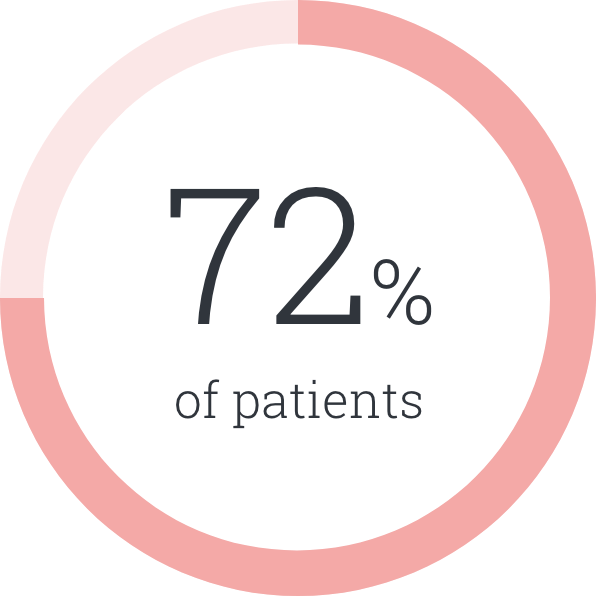
72% of patients with a single SDMA increase risk further impairments in GFR13
Results of a retrospective analysis in which 16,523 dogs and 16,454 cats had three or more SDMA results and the first result was within the reference interval.
What to do when SDMA is increased and other markers are normal
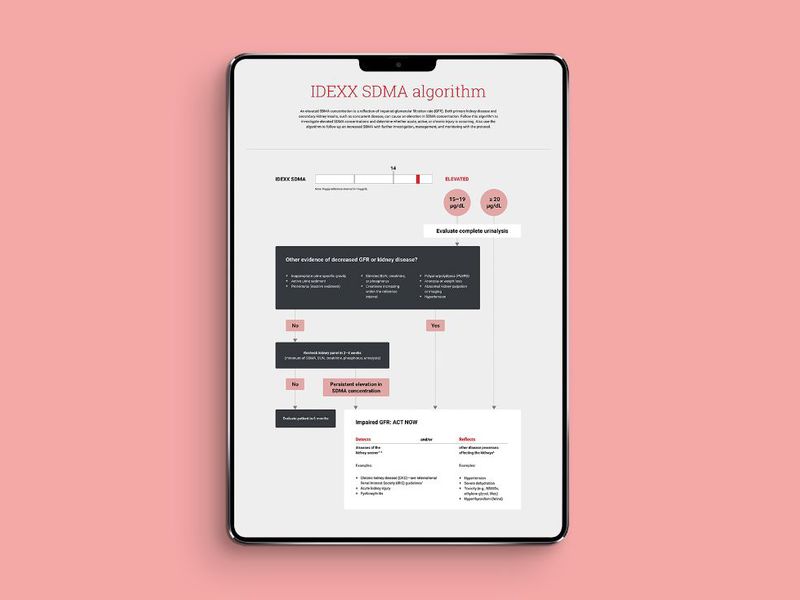
Use the IDEXX SDMA algorithm to interpret results
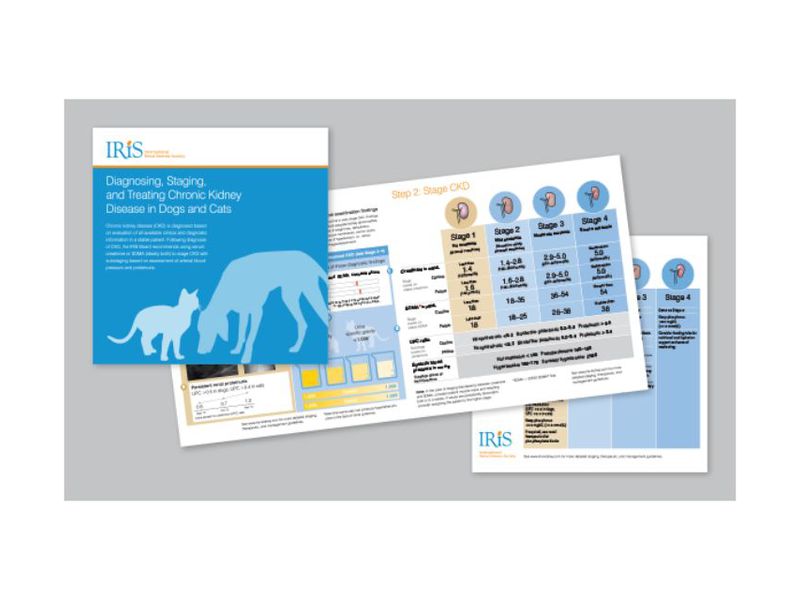
Follow the International Renal Interest Society (IRIS) guidelines to stage and treat chronic kidney disease
Peer-reviewed studies support SDMA

More sensitive than creatinine1–3,16
SDMA is a sensitive indicator of renal function in dogs. Creatinine doesn't increase until up to 75% loss of kidney function, whereas SDMA increases with as little as 25% loss of kidney function.

Less impacted by extrarenal factors1,17
Unlike creatinine and urea, SDMA is not affected by factors that can overestimate GFR. SDMA is specific for kidney function and less impacted by extrarenal factors, including body condition, advanced age, and disease state.
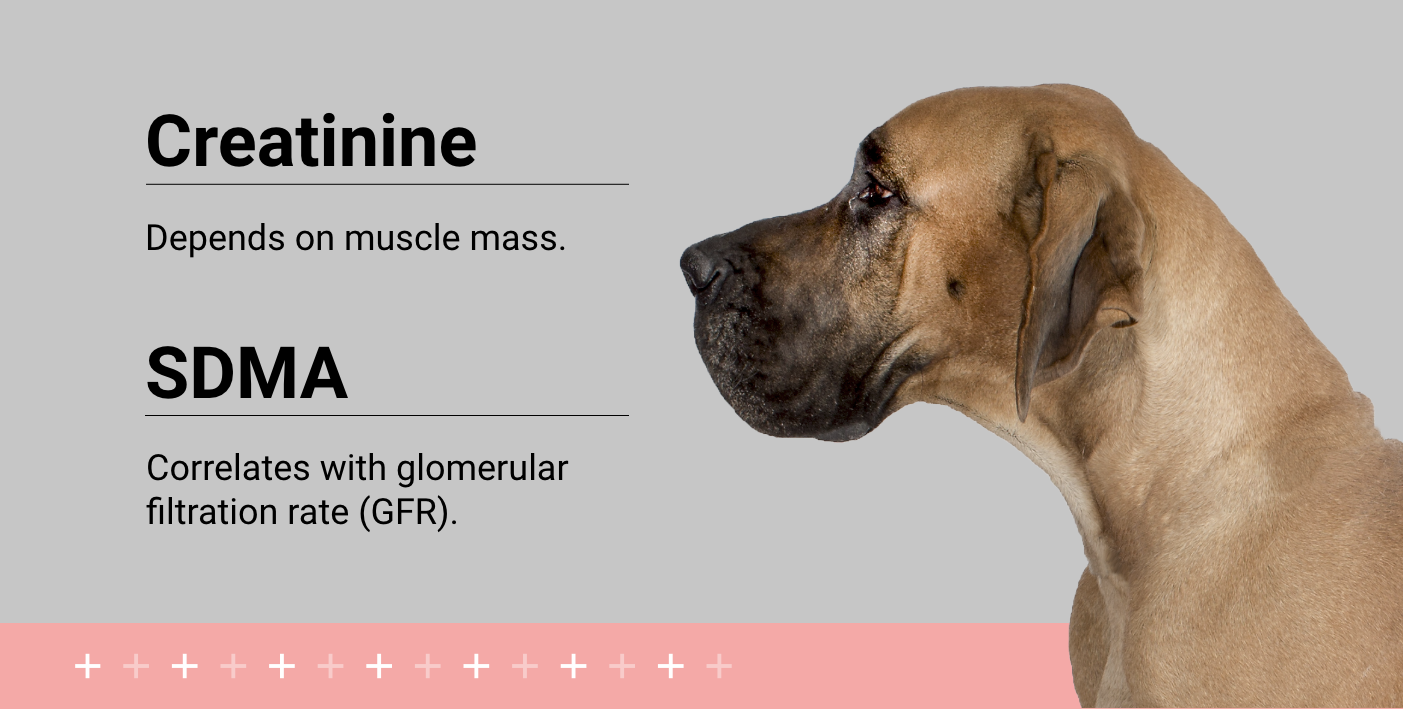
More reliable than creatinine1–3,16,17
SDMA is more reliable than creatinine in aging cats with muscle wasting.4,5

Increases earlier than creatinine in cats16
Results of a retrospective longitudinal study2 that includes 21 cats with chronic kidney disease (CKD) show that SDMA increased 17 months earlier than serum creatinine on average (range 1.5–48 months).

Increases earlier than creatinine in dogs2
SDMA increases earlier than creatinine in dogs with CKD. Results of a retrospective longitudinal study3 that includes 19 dogs with CKD show that SDMA increased 9.8 months earlier than serum creatinine on average (range 2.2–27 months).
Two options: same reliable results
![]() The in-house Catalyst SDMA Test, with multiple SDMA-inclusive profiles to meet your patient and practice needs.
The in-house Catalyst SDMA Test, with multiple SDMA-inclusive profiles to meet your patient and practice needs.
![]() The IDEXX SDMA Test, included with every chemistry panel or as a stand-alone test from IDEXX Reference Laboratories.
The IDEXX SDMA Test, included with every chemistry panel or as a stand-alone test from IDEXX Reference Laboratories.
Note: SDMA is symmetric dimethylarginine.
*These IDEXX SDMA medical claims are supported by extensive scientific evidence.
References
- Hall JA, Yerramilli M, Obare E, Yerramilli M, Yu S, Jewell DE. Comparison of serum concentrations of symmetric dimethylarginine and creatinine as kidney function biomarkers in healthy geriatric cats fed reduced protein foods enriched with fish oil, L-carnitine, and medium-chain triglycerides. Vet J. 2014;202(3):588–596. doi:10.1016/j.tvjl.2014.10.021
- Hall JA, Yerramilli M, Obare E, Yerramilli M, Almes K, Jewell DE. Serum concentrations of symmetric dimethylarginine and creatinine in dogs with naturally occurring chronic kidney disease. J Vet Intern Med. 2016;30(3):794–802. doi:10.1111/jvim.13942
- Nabity MB, Lees GE, Boggess MM, et al. Symmetric dimethylarginine assay validation, stability, and evaluation as a marker for the early detection of chronic kidney disease in dogs. J Vet Intern Med. 2015;29(4):1036–1044. doi:10.1111/jvim.12835
- Nabity MB. Traditional renal biomarkers and new approaches to diagnostics. Toxicol Pathol. 2018;46(8):999–1001. doi:10.1177/0192623318800709
- Hall JA, Yerramilli M, Obare E, Li J, Yerramilli M, Jewell DE. Serum concentrations of symmetric dimethylarginine and creatinine in cats with kidney stones. PLoS One. 2017;12(4):e0174854. doi:10.1371/journal.pone.0174854
- Burton W, Drake C, Ogeer J, et al. Association between exposure to Ehrlichia spp. and risk of developing chronic kidney disease in dogs. J Am Anim Hosp Assoc. 2020;56(3):159–164. doi:10.5326/JAAHA-MS-7012
- Dahlem DP, Neiger R, Schweighauser A, et al. Plasma symmetric dimethylarginine concentration in dogs with acute kidney injury and chronic kidney disease. J Vet Intern Med. 2017;31(3):799–804. doi:10.1111/jvim.14694
- Drake C, Coyne M, McCrann DJ, Buch J, Mack R. Risk of development of chronic kidney disease after exposure to Borrelia burgdorferi and Anaplasma spp. Top Companion Anim Med. 2021;42:100491. doi:10.1016/j.tcam.2020.100491
- Szlosek D, Robertson J, Quimby J, et al. A retrospective evaluation of the relationship between symmetric dimethylarginine, creatinine and body weight in hyperthyroid cats. PLoS One. 2020;15(1):e0227964. doi:10.1371/journal.pone.0227964
- Yerramilli M, Farace G, Quinn J, Yerramilli M. Kidney disease and the nexus of chronic kidney disease and acute kidney injury: the role of novel biomarkers as early and accurate diagnostics. Vet Clin North Am Small Anim Pract. 2016;46(6):961–993. doi:10.1016/j.cvsm.2016.06.011
- Mack RM, Hegarty E, McCrann DJ, Michael HT, Grauer GF. Longitudinal evaluation of symmetric dimethylarginine and concordance of kidney biomarkers in cats and dogs. Vet J. 2021;276:105732. doi:10.1016/j.tvjl.2021.105732
- Michael HT, Mack RM, Hegarty E, McCrann DJ, Grauer GF. A longitudinal study of the persistence of increased creatinine and concordance between kidney biomarkers in cats and dogs. Vet J. 2021;276:105729. doi:10.1016/j.tvjl.2021.105729
- Data on file at IDEXX Laboratories, Inc. Westbrook, Maine USA.
- Vaske HH, Schermerhorn T, Grauer GF. Effects of feline hyperthyroidism on kidney function: a review. J Feline Med Surg. 2016;18(2):55–59. doi:10.1177/1098612X15575385
- Little S, Levy J, Hartmann K, et al. 2020 AAFP feline retrovirus testing and management guidelines. J Feline Med Surg. 2020;22(1):5–30. doi:10.1177/1098612X19895940
- Hall JA, Yerramilli M, Obare E, Yerramilli M, Jewell DE. Comparison of serum concentrations of symmetric dimethylarginine and creatinine as kidney function biomarkers in cats with chronic kidney disease. J Vet Intern Med. 2014;28(6):1676–1683.
- Hall JA, Yerramilli M, Obare E, Yerramilli M, Melendez LD, Jewell DE. Relationship between lean body mass and serum renal biomarkers in healthy dogs. J Vet Intern Med. 2015;29(3):808–814. doi:10.1111/jvim.12607